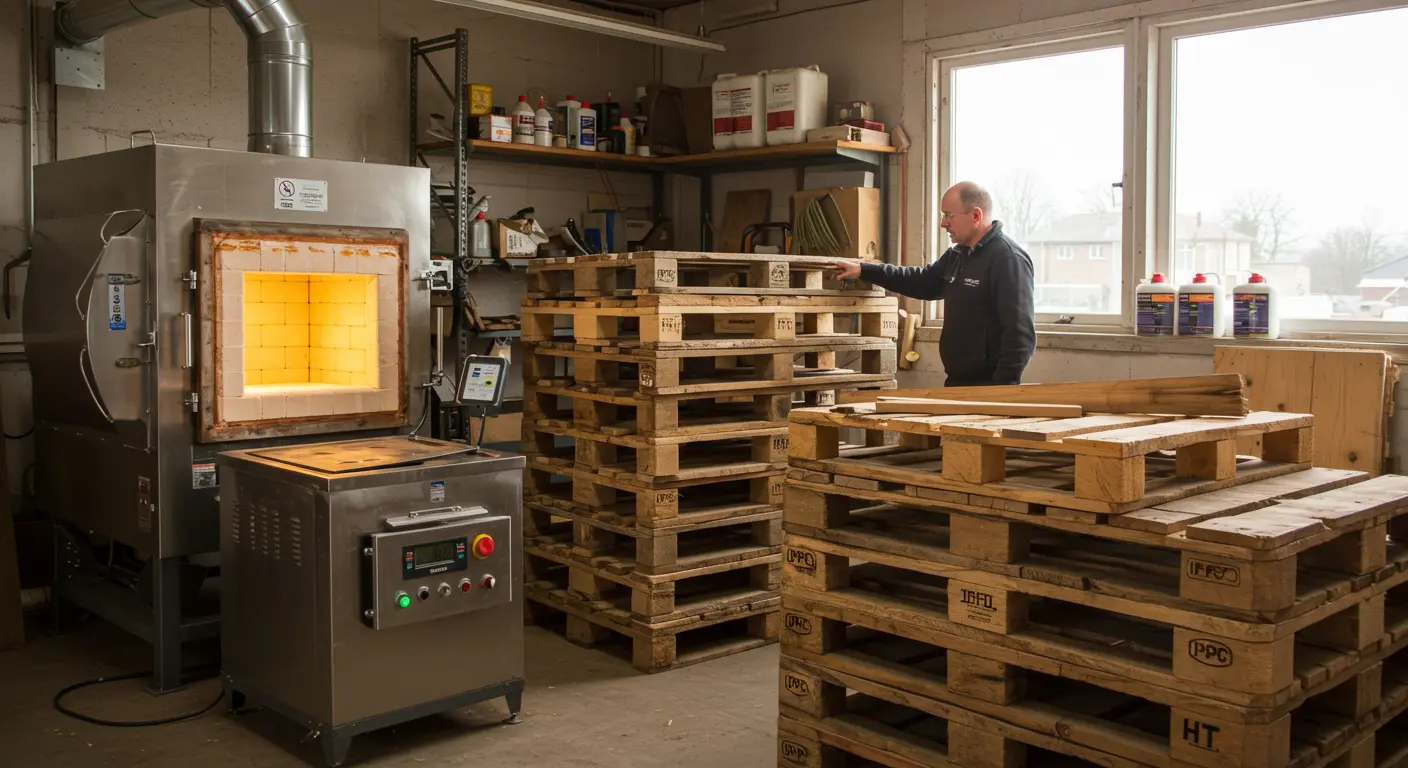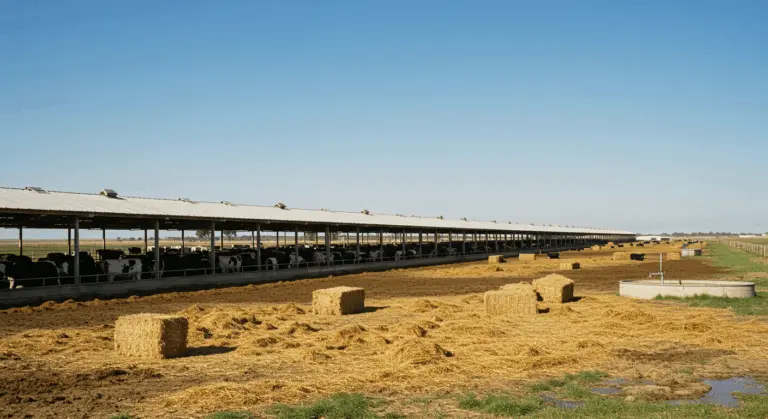Understanding Pallet Wood Treatment
Wooden pallets undergo treatment to ensure they’re safe for industrial use and international shipping. This process sterilizes the wood, eliminating pests and other biological contaminants that could otherwise spread during transport. Heat treatment in specialized kilns represents the most common approach—a method that avoids potentially harmful chemicals to handlers or the environment.
Pallet wood treatment goes beyond good practice—it’s frequently a regulatory mandate, especially for pallets used in international shipping. These treatments help prevent the accidental transportation of invasive species across borders, which could devastate local ecosystems and agriculture. Understanding the different treatment methods, their effectiveness, and how to identify properly treated pallets is essential for businesses in logistics and for individuals repurposing pallet wood.
Heat Treatment – What It Is and How It Works
Heat treatment is the most common and environmentally friendly method used to treat wooden pallets. This process involves placing pallets in specialized kilns where they’re heated to a core temperature of at least 56°C (132.8°F) and maintained at this temperature for a minimum of 30 minutes. This temperature-time combination eliminates harmful organisms, including insects, larvae, and fungi that might otherwise compromise wood integrity.
The heat penetrates deep into the wood’s core, ensuring complete sterilization without compromising structural integrity. Unlike chemical treatments, this process leaves no harmful residues—making the pallets safe for handling food and other sensitive goods. Additionally, the process reduces moisture content, improving stability and minimizing warping risk.
Heat-treated pallets are especially important for international shipping, as they comply with International Standards for Phytosanitary Measures No. 15 (ISP 15) regulations. These standards were established to prevent invasive species from crossing borders through wooden packaging materials. Companies exporting goods internationally must use compliant pallets to avoid shipment delays, rejections, or potential fines. The growing preference for heat treatment over chemical alternatives like methyl bromide reflects both regulatory trends and increasing environmental consciousness across global supply chains.
Methyl Bromide Treatment – Risks and Regulations
Methyl bromide treatment is an alternative method for treating wooden pallets, but one that comes with significant concerns. This process involves fumigating pallets with methyl bromide gas to eliminate pests and pathogens. Unlike heat treatment, this chemical approach raises significant environmental and health concerns.
Methyl bromide carries substantial risks. As an ozone-depleting substance, exposure can cause serious health issues for workers—including respiratory and neurological damage. Residues may also contaminate products, creating particular concerns for food and pharmaceutical industries.
These concerns have prompted strict regulations. The Montreal Protocol has phased out general methyl bromide use, allowing exceptions only for critical applications. Moreover, it’s not recommended for wood thicker than 20 cm, as the gas may not penetrate deeply enough for effective treatment.
Regulatory bodies now strongly favor heat treatment. Pallets marked “MB” (methyl bromide) are becoming increasingly rare as the industry shifts toward the safer “HT” (heat-treated) alternative. This transition reflects growing environmental and safety awareness—knowing these distinctions helps businesses and consumers make responsible choices.
Importance of ISP 15 Compliance
International Standards for Phytosanitary Measures No. 15 (ISP 15) is a critical framework for wood packaging in global trade, specifically designed to prevent international pest spread. For businesses engaged in international shipping, ISP 15 compliance is a fundamental requirement that directly impacts supply chain efficiency.
ISP 15 mandates specific treatment protocols to ensure wooden packaging materials are free from harmful organisms. The standard requires specific treatment protocols and clear marking systems to verify compliance. By establishing uniform treatment requirements, ISP 15 creates a consistent global approach to biosecurity that protects agricultural resources and natural environments worldwide.
The consequences of non-compliance with ISP 15 can be severe and costly. Shipments with non-compliant pallets face risks such as:
-
Rejection at ports of entry, leading to significant delays and extra costs.
-
Quarantine or destruction of the entire shipment by customs authorities.
-
Forced on-site treatment of the non-compliant materials.
-
Financial losses from product damage, delays, and fines.
To achieve ISP 15 compliance, pallets must undergo approved treatment—with heat treatment (HT) as the most common method. Following treatment, compliant pallets receive an official stamp for traceability and verification purposes.
As global trade continues expanding, ISP 15 compliance and enforcement have grown increasingly stringent. Businesses must stay informed about evolving regulations and partner with certified suppliers to ensure smooth operations. Using compliant pallets protects individual shipments while safeguarding the global ecosystem from devastating pests.
Identifying Treated vs. Untreated Pallets
Distinguishing between treated and untreated pallets requires careful examination of specific markings and visual indicators. The most reliable indicator of treatment status is the presence of specific markings that conform to international standards. These visual cues provide critical information about how the pallet was processed and whether it’s suitable for your intended purpose.
A compliant pallet displays an IPC (International Plant Protection Convention) stamp—resembling a wheat symbol. This stamp, typically found on a block or stringer, provides essential information including:
Unmarked pallets pose significant risks. Without knowing their history, they could harbor pests or have absorbed chemical spills—creating health and environmental hazards if repurposed.
Always prioritize pallets bearing clear IPC markings, particularly “HT” (heat-treated) ones, which remain chemical-free. When a pallet’s history remains uncertain, choosing one with verifiable markings is the safest approach to avoid potential health, regulatory, and environmental complications.
Recycled Wooden Pallets – Are They Safe?
Recycled wooden pallets have clear benefits, though their safety demands careful evaluation. Key advantages include:
However, the primary safety concern with recycled pallets stems from their unknown history. It’s often impossible to determine whether a pallet encountered toxic chemicals or contaminants during its previous applications. These unknown factors could potentially compromise both the structural integrity of the wood and the safety of anyone handling the pallet or using it for repurposing projects.
Pallets originating from regions like the UK, Canada, and the US typically adhere to stricter safety standards, favoring heat treatment over chemical fumigation methods.
When sourcing recycled pallets, seek clear “HT” (heat-treated) markings—this method remains chemical-free and safer for repurposing projects. Avoid pallets marked “MB” (methyl bromide) or any displaying signs of spills, unusual odors, or discoloration, as these indicate potential contamination.
For maximum safety when working with recycled pallets, take the following precautions:
-
Wear protective gear, including gloves and a dust mask.
-
Clean the wood thoroughly before use.
-
Seal the wood with a food-safe finish, especially for indoor projects or those involving food.
Weatherproofing Treatments for Outdoor Use
When utilizing pallet wood for outdoor projects, standard ISP 15 treatments aren’t enough—they don’t protect against weather elements. Weatherproofing becomes essential to extend wood lifespan when facing moisture, UV radiation, and natural decay processes.
Common weatherproofing options include:
-
Water-repellent sealants: Create a barrier against moisture to prevent warping and splitting.
-
UV-resistant stains: Add color and contain blockers to prevent sun damage and fading.
-
Outdoor coatings: Offer comprehensive protection by combining water resistance with mold and mildew inhibitors.
Weatherproofing is a separate process from the regulatory ISP 15 treatment pallets receive during manufacturing. While heat treatment eliminates pests effectively, it provides no weather protection—making supplementary weatherproofing crucial for outdoor applications.
Before applying weatherproofing products, verify compatibility with the pallet’s original treatment. Most products work well with HT pallets, but always consult manufacturer recommendations. Exercise particular caution with MB-treated pallets, where chemical interactions may occur.
The application process typically involves thorough surface preparation, followed by even product application using brushes, rollers, or sprayers. Multiple coats are often recommended for maximum protection, particularly for wood that will be exposed to harsh weather conditions or direct ground contact. With proper weatherproofing, pallet wood can withstand outdoor conditions for years, making it a sustainable and economical choice for exterior projects ranging from garden furniture to decorative structures.



